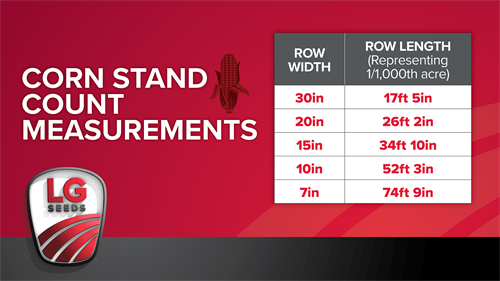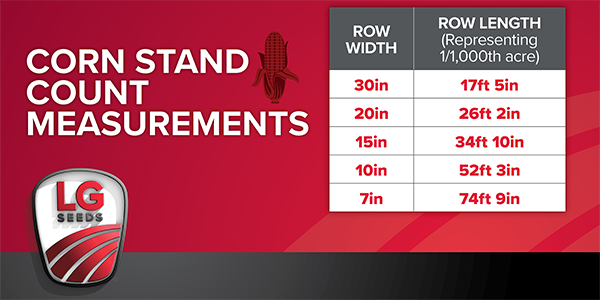AGRONOMICSUPPORT
YOU CAN TAKETO THE FIELD
How To Check Corn Emergence and Stand Count After Planting
Scouting fields and checking corn emergence (especially when plants are in the V1-V2 stage) allows you to predict your yield, understand how each hybrid is performing compared to others around it and make informed decisions about any changes you might need to make to your planting plan in the future.
But what exactly should you be looking for? When checking corn emergence, keep your eye on three elements:
Population
After planting is done and corn is past the VE stage, it’s time to start conducting stand counts to evaluate emergence. Start by using the table below to quickly understand how far to measure for a stand count, based on your crop’s row width.


If you planted in 30-inch rows, walk at least 50 paces into the field (past the end rows) and measure 17 feet, 5 inches down the center of a row. Then, count the plants on both sides of the tape measure and find the average of the two numbers. Multiply your average number by 1,000 to get your “in-ground” population per acre.
Does that number match the population you planted at? It’s common for the in-ground population to be slightly lower than your planting population, but if your in-ground and planting populations are significantly different, get in touch with your local LG Seeds agronomist for a consult.
Uniformity
Consistent, uniform emergence is the goal. You want all the corn plants to come out of the ground at the same time. If they don’t, late-emerging corn plants will be developmentally behind and act as a weed to corn plants that are further along in their growth. Take a look around the field and evaluate – do the plants look consistent, or does appearance change row by row? Did the plants come up at the same time, or are there stragglers?
 The best way to check whether some plants stayed in the ground longer than others is to stage each one by their collars. If most of the plants have the same number of collars, you’ve achieved uniformity. If plants in the same area have varied numbers of collars, this is when you’ll see the smaller plants not reaching their full potential and instead acting as weeds competing with the larger, consistent plants. Inconsistent emergence can lead to lower yield – if you notice inconsistent emergence in your field, get in touch with your LG Seeds agronomist to determine the cause and make a plan to for even emergence in the future.
The best way to check whether some plants stayed in the ground longer than others is to stage each one by their collars. If most of the plants have the same number of collars, you’ve achieved uniformity. If plants in the same area have varied numbers of collars, this is when you’ll see the smaller plants not reaching their full potential and instead acting as weeds competing with the larger, consistent plants. Inconsistent emergence can lead to lower yield – if you notice inconsistent emergence in your field, get in touch with your LG Seeds agronomist to determine the cause and make a plan to for even emergence in the future.
Vigor
How fast and how strong did the hybrid come out of the ground? This will give you valuable information about where to position that hybrid moving forward. Hybrids with higher vigor scores (the ones that are quick to emerge) are hybrids you can put through tougher conditions and expect reliable results. Those with lower vigor scores (meaning they’re slower to emerge) should be planted in prime conditions to ensure you achieve the yield you’re looking for.
The best way to evaluate vigor is with a flag test. Visit the field every day around the same time and place a flag next to the plants that have emerged. Use a new color flag every day, and continue this process until the crop is fully emerged. The goal is to have minimal to no variation in flag color, representing that all the plants emerged on the same day.
Flag tests for vigor can be difficult and time-consuming. If you’re not able to conduct a flag test on your farm, follow up with your local LG Seeds DSM or agronomist to see results from a flag test at a plot near you.
Get Reliable Results
These small details can help you achieve reliable results. Follow up with your local LG Seeds DSM or agronomist to learn more about early season crop health.





